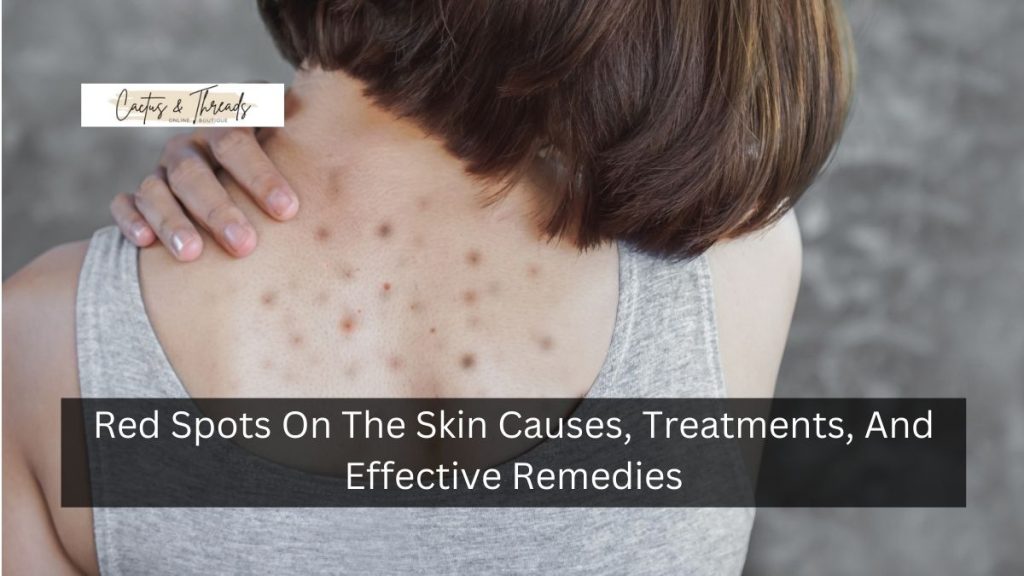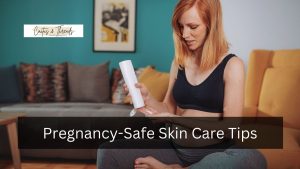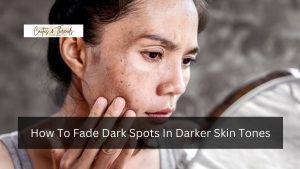
Red spots on the skin can be alarming, but they are often harmless and manageable with the right knowledge. These spots can appear suddenly and vary in size, shape, and intensity.
While some causes of red spots are minor, others may require medical attention. In this article, we’ll explore the causes, treatments & preventive measures for red spots on the skin.
Understanding Red Spots: Common Causes
Numerous things, including environmental variables and skin diseases, might result in red patches. These are a few of the most typical reasons:
1. Skin Allergies
Allergic reactions can result in red, itchy spots or patches on the skin. These allergies can be due to specific foods, medications, insect bites, or skin care products.
Hives, or urticaria, is a common skin reaction that appears as red, raised, itchy welts. Avoiding known allergens can prevent outbreaks, and antihistamines are often helpful in alleviating symptoms.
2. Heat Rash
Heat rash, also called prickly heat or miliaria, appears as clusters of small red spots or bumps and is often itchy. It occurs when sweat ducts become blocked & trapped under the skin, commonly due to hot and humid conditions. Wearing light, breathable clothing and keeping the skin cool can help reduce the likelihood of heat rash.
3. Infections
Red patches can also be a symptom of several bacterial, viral, and fungal illnesses. For instance, the chickenpox virus produces tiny, blistering red spots, and other frequent illnesses that generate red spots include ringworm and impetigo. These infections can be treated in a variety of ways, including with topical or oral drugs.
4. Skin Conditions
Several chronic skin conditions can cause red spots, including:
- Eczema (Atopic Dermatitis): Often leads to red, itchy patches, especially in children.
- Psoriasis: Causes scaly red patches, commonly on the elbows, knees, and scalp.
- Rosacea: Typically results in facial redness, especially on the cheeks and nose, and may develop into visible red spots or pimples.
5. Petechiae And Purpura
Petechiae are small, round red or purple spots caused by bleeding under the skin, often due to injury, infections, or side effects of medications.
Purpura are similar but larger, typically appearing in clusters. Petechiae and purpura may indicate an underlying medical condition, so it’s essential to seek medical advice if you experience these symptoms.
Treatments For Red Spots On The Skin
The treatment for red spots depends largely on the underlying cause. Below are several effective treatments for various types of red spots:
1. Topical Creams And Ointments
Topical creams, especially those containing hydrocortisone or other corticosteroids, can reduce redness & swelling for conditions like eczema and mild allergic reactions. For fungal infections such as ringworm, antifungal creams can be effective.
2. Antihistamines
If red spots are due to an allergic reaction, antihistamines can help manage symptoms by reducing itchiness and inflammation. Oral antihistamines are available over the counter and can help reduce discomfort associated with hives and other mild allergic reactions.
3. Antibiotics And Antivirals
In cases where red spots are caused by bacterial or viral infections, antibiotics or antiviral medications may be necessary. For example, antibiotics can treat bacterial infections like impetigo, while antivirals are essential for chickenpox and other viral infections.
4. Moisturizers And Skin Hydration
Moisturizing the skin can alleviate symptoms of eczema, psoriasis, and dry skin, all of which can cause red spots. Using a fragrance-free moisturizer after bathing helps retain skin moisture and improve its barrier function. Products containing ceramides or hyaluronic acid can be especially beneficial.
5. Light Therapy
For chronic skin conditions like psoriasis and rosacea, light therapy (also called phototherapy) can reduce inflammation and skin cell turnover. This therapy uses specific wavelengths of light to treat skin conditions & must be administered by a healthcare provider.
Natural Remedies For Red Spots
If you prefer natural remedies, several home-based treatments can help alleviate red spots:
1. Aloe Vera
Aloe vera has soothing and anti-inflammatory properties that can help reduce redness and irritation. Applying fresh aloe vera gel directly to red spots can be beneficial, particularly for sunburns, heat rash, and allergic reactions.
2. Cold Compress
Applying a cold compress can reduce inflammation and numb itching for red spots caused by heat rash or allergies. Simply wrap ice in a cloth and apply it to the affected area for 10–15 minutes.
3. Coconut Oil
Coconut oil is a natural moisturizer with antibacterial and anti-inflammatory properties. It’s especially helpful for managing eczema and dry skin conditions that cause red patches. Apply a small amount to the skin and massage gently to improve hydration.
4. Green Tea Extract
Green tea has antioxidants that may benefit the skin by reducing inflammation and redness. Using green tea extract in a topical form or applying cooled green tea bags to the skin may offer relief, particularly for rosacea.
Preventing Red Spots On The Skin
Taking proactive measures to care for your skin can help prevent red spots. Here are a few preventive tips to keep your skin clear and healthy:
1. Use Sunscreen Daily
Sun exposure can worsen many skin conditions, so applying a broad-spectrum sunscreen with SPF 30 or higher is essential for protecting the skin. Reapply every two hours if you’re outdoors for extended periods.
2. Avoid Harsh Products
Avoid using harsh soaps, exfoliants, or alcohol-based products that can irritate the skin. Opt for fragrance-free and hypoallergenic products to reduce the risk of allergic reactions.
3. Wear Breathable Fabrics
In hot and humid conditions, wear loose, breathable fabrics to reduce sweating and minimize the risk of heat rash. Cotton is an excellent choice for allowing the skin to breathe.
4. Stay Hydrated
Drinking plenty of water keeps your skin hydrated and helps flush toxins from the body, reducing the likelihood of red spots from dryness or irritation. Aim for at least eight glasses a day.
5. Manage Stress Levels
High-stress levels can exacerbate skin conditions like eczema and acne, leading to more red spots. Incorporating stress-relieving practices like meditation, exercise, or breathing exercises can improve skin health.
When To See A Doctor
While most red spots are harmless, certain symptoms indicate a need for medical attention:
- Painful spots: If spots are painful, swollen, or rapidly spreading.
- Fever: If you experience a fever or general discomfort along with red spots.
- Persistent spots: If spots do not improve with home treatments or over-the-counter remedies.
Consulting a dermatologist can help you find the correct diagnosis and receive appropriate treatment.
Conclusion:
Numerous things, ranging from simple skin irritations to underlying medical issues, can cause red patches on the skin. You may control or even get rid of red spots by being aware of their causes, using efficient treatments, and keeping up preventative measures. To maintain healthy and glowing skin, follow proper skincare routines & don’t hesitate to see a doctor if you encounter any worrisome signs.







